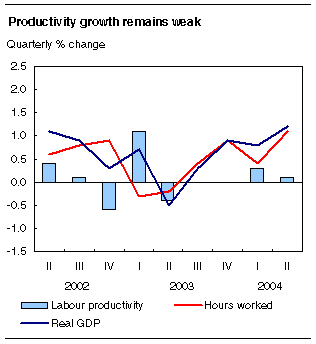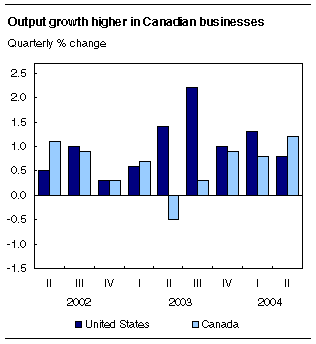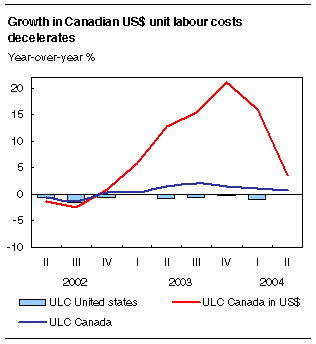
















 |
|
 |                |
Information identified as archived is provided for reference, research or recordkeeping purposes. It is not subject to the Government of Canada Web Standards and has not been altered or updated since it was archived. Please "contact us" to request a format other than those available.

|

Monday, September 13, 2004 Labour productivity, hourly compensation and unit labour costSecond quarter 2004Labour productivity in Canada's business sector inched up between April and June, as economic output and hours worked grew at almost the same pace. Productivity increased 0.1% in the second quarter, continuing the lacklustre performance that began a year ago. After posting a strong 1.1% gain in the first quarter of 2003, productivity has been virtually flat for five consecutive quarters. 
However, with the appreciation of the Canadian dollar slowing in early 2004, Canadian businesses significantly increased their exports in the second quarter with their unit labour costs stabilized in relation to their American counterparts. Productivity, as measured by output per hour worked, improves when gross domestic product (GDP) increases more rapidly than the number of hours worked. Productivity growth contributes to raising and maintaining the living standard of Canadian residents.
In the second quarter, real GDP in the business sector rose 1.2%, while the number of hours worked went up an almost identical 1.1%. South of the border, growth in labour productivity in the American business sector outpaced that in Canada for the fifth consecutive quarter, although it slowed considerably. Productivity increased by only 0.4% in the United States between April and June, less than half the rate in the first quarter. US productivity has fluctuated since the third quarter of 2003. Stronger output growth but no productivity gains in CanadaGrowth in real GDP in Canada's business sector in the second quarter of 2004 was stronger than in the American business sector for the first time since the first quarter of 2003. Economic output among Canadian businesses increased 1.2% between April and June, a faster pace than the growth of 0.8% in the first quarter. This faster pace was largely attributable to the surge in exports (+5.0%). 
In contrast, the pace of growth in output among American businesses decelerated to 0.8% in the second quarter, well below the 1.3% in the first quarter. This deceleration was due both to the slowdown in the growth of spending by American consumers and strong goods and services imports. However, growth in spending by businesses offset most of these two sources of slowdown. In Canada, the sharp growth in output was accompanied by a more dynamic labour market. While production hours worked in Canadian businesses rose by 0.4% in the first quarter, they experienced a marked 1.1% increase in the second quarter. Meanwhile, hours worked in American businesses increased by only 0.4% in the second quarter. Growth in hours worked in the United States has continued at about the same pace in the last four quarters, increasing on average by 0.4% per quarter during this period. The higher productivity performance in the United States was due mainly to a very different performance of its labour market in the second quarter. Despite the fact that growth in real GDP was more robust in Canada than in the United States in the second quarter, the weaker labour market south of the border allowed American businesses to post higher productivity gains than in Canada. Unit labour costs in US dollars continue to rise, but at slower paceAs was the case with productivity, the United States continued to have a significant advantage over Canada with respect to unit labour costs in the second quarter, especially when the exchange rate was taken into account. However, the annual gap in unit labour costs that has favoured the United States since the fourth quarter of 2002 narrowed considerably in the second quarter. Thus, Canadian businesses regained some of the competitiveness lost to their American counterparts since the first quarter of 2003. This situation aided the rise in real exports to the United States between April and June. On a year-over-year basis, the growth in labour costs per unit of output of the Canadian businesses has gradually slowed during the last four quarters, when measured in Canadian dollars. During the second quarter of 2004, unit labour costs rose only 0.7%, a substantial deceleration from a gain of 2.0% in the third quarter of 2003. Meanwhile, American businesses have seen their unit labour costs fall or remain flat over the last 10 quarters. In the second quarter of 2004, unit labour costs in the United States remained stable, compared with the same quarter a year earlier. Unit labour costs last rose in the United States on a year-over-year basis during the last quarter of 2001 when they went up 0.4%. 
The stronger Canadian dollar had a marked impact on unit labour costs in Canada. Measured in US dollars, labour costs in Canada recorded double-digit increases through the last three quarters of 2003. However, unit labour costs in Canada expressed in US dollars have recently slowed as the climb in the value of the Canadian dollar has stalled. Between April and June of 2004, unit labour costs in Canada increased only 3.5% on a year-over-year basis as the value of the Canadian dollar relative to the US greenback experienced its smallest appreciation during the past six quarters. This compares with a gain of 16.0% during the first quarter of this year. Recent revisions in the United States impacted the 2001 and 2002 productivity gapsThe United States recently made revisions to its labour productivity estimates. Data released today incorporates these revisions in American data affecting both GDP and hours worked. American GDP estimates have been revised back to the first quarter of 2001, while measures of hours worked have been revised retroactively to 1947 to reflect new estimates for hours of work for non-production workers and those designated as supervisory workers. No corresponding revision to hours worked has been done in Canada. The most recent revisions for the last four years of GDP in Canada were released in the Daily on June 11, 2004.
For recent years, revisions to American data have resulted in an increase in the growth of labour productivity in the United States in 2001 and a reduction in 2002. The growth rates for 2000 and 2003 remained unchanged. For 2001, productivity growth in the United States rose from 2.2% before revision to 2.5% after revision, which is greater than the 1.4% growth observed in Canada during the same year. In contrast, American productivity growth in 2002 was revised downward from 4.9% to 4.3%. This revised rate, however, was still higher than the rate in Canada, which was 2.3% for the same period. It is evident that these revisions do not significantly modify the comparisons made in recent years between these two countries. The productivity gap in favour of the United States remains. The gap in productivity growth in favour of the United States for the 2000 to 2003 period changed from 2.5 percentage points before revision to 2.4 percentage points after revision. However, it is important to note that the annual productivity differences for this period are based on preliminary data, which are subject to revisions. The revisions also had almost no effect on the period representing Canada's last economic cycle. Between 1989 and 2000, the average gap in annual productivity growth in favour of the United States remained low (+0.3 percentage points). The third quarter 2004 data for labour productivity, hourly compensation and unit labour cost will be released on December 10. Available on CANSIM: tables 383-0008 and 383-0012. Definitions, data sources and methods: survey number 5042. A more comprehensive analysis, including additional charts and tables, is now available in the Canadian Economic Accounts Quarterly Review, Vol. 3, no. 2 (13-010-XIE, free). From the Our products and services page, under Browse our Internet publications, choose Free, then National accounts. To order data, contact Client Services (productivity.measures@statcan.gc.ca). For more information, or to enquire about the concepts, methods or data quality of this release, contact Jean-Pierre Maynard (613-951-3654; fax: 613-951-3292; maynard@statcan.gc.ca), Micro-Economic Analysis Division.
| |||||||||||||||||||||||||||||||||||||||||||||||||||||||||||||||||||||||||||||||||||||||||||||||||||||||||||||||||||||||||||||||||||||||||||||||||||||||||||||||||||||||||||||||||||||||||||||||||||||||||||||||||||||||||||||||||||||||||||||||||||||||||||||||||||||||||||||||||||||||||||||||||||||||||||||||||||||||||||||||||||||||||||||||||||||||||||||||||||||||||||||||||||||||||||||||||||||||
|
|
|